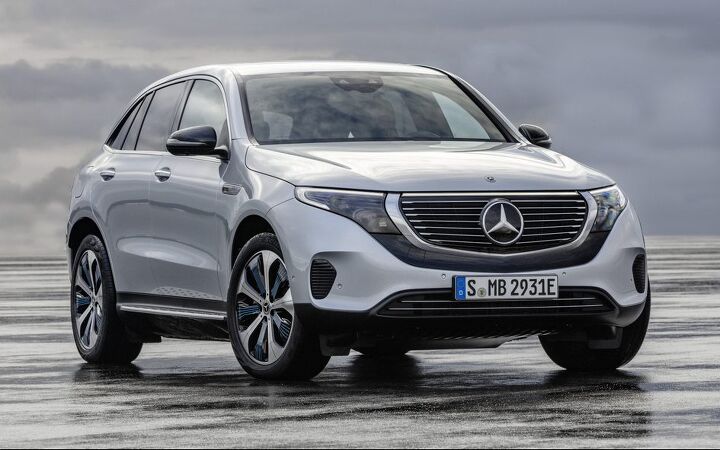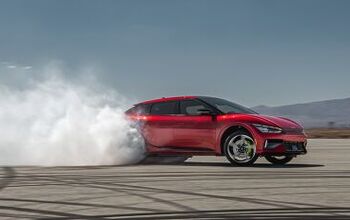Shocker: Electric Cars Are Still, Generally, a Plaything of the Wealthy

Pick your jaw up off the floor. As automakers struggle to offer electric vehicles deemed “affordable” by the motoring public, those buyers aren’t exactly swamping dealers with requests for EVs.
Even in the Europe Union, members of which punish drivers of fossil fuel-powered vehicles with high taxes, EVs amounted to just 2 percent of new vehicles registered last year. And yet the EU plans to drastically cut down on greenhouse gas emissions in the coming years.
New data from the European Automobile Manufacturers’ Association (ACEA) shows that the EU’s green dreams will be hard to realize without some sort of massive incentive for the purchase of electric vehicles, as right now those vehicles are only marginally popular in extremely wealthy countries. The EV “people’s car” is still a dream.
The report shows an EV take rate of less than 1 percent in half of the EU’s member states. The lower a country’s per capita GDP, the lower the take rate.
Only two European countries that boast an EV market share above 5 percent are Sweden and the Netherlands. Finland clears the 3.5 percent mark. What all three countries have in common is a per capita GDP greater than $47,000. Those sub-1-percenters? They all have per capita GDPs below $32,500.
ACEA’s findings show that more than 80 percent of the EU’s electric vehicle sales originate in just six countries, all of them wealthy. On the lower income end of the scale, Latvia sold just 93 EVs last year. Poland boasts a take rate of 0.2 percent, while Slovakia and Greece barely top that, at 0.3 percent.
Automakers have miles to go before the “common man” begins snapping up electric cars in numbers large enough to satisfy the EU. And scarce, unprofitable $35,000 EV sedans are not that vehicle.
Sure, the study’s findings hardly come as a surprise, as high battery costs necessitate a vehicle with a price tag capable of recouping those additional expenses. Profitability can’t be an afterthought in a declining sales environment. Who’s fielding splashy new EVs these days? Jaguar, Mercedes-Benz, Audi, and other luxury brands. While companies like Nissan and Renault are still big players in the EV game, even those brands’ electrics aren’t bargain basement strippers with rock-bottom MSRPs.
If governments try to legislate away the existence of ICE-powered vehicles, they just might find themselves facing an angry, carless society. The solution, according to the ACEA, is more government intervention.
“Besides investing in charging infrastructure, governments across the EU need to put in place meaningful and sustainable incentives in order to encourage more consumers to make the switch to electric,” said ACEA Secretary General Erik Jonnaert at a press conference in Barcelona.
“People throughout the EU should be able to consider purchasing an electric vehicle – no matter which country they live in – north or south, east or west. The affordability of the latest low- and zero-emission technologies needs to be addressed by governments as a matter of priority.”
On the manufacturing side of things, several automakers hope to achieve their goal of an affordable EV. Honda has a new EV city car on the way for European buyers, price tag unconfirmed. Volkswagen’s MEB platform, which forms the underpinnings of a massive product tsunami, will one day propel a car with a price tag in the low $20k range, VW says. The automaker has tapped its Seat brand to lead the affordable EV charge.
Meanwhile, Chinese automakers hope to capitalize on the dearth of low-priced EVs with offerings like the Geometry brand, a creation of Geely Auto Group.
With Europe struggling to make EVs a “thing,” one wonders what domestic automakers can expect when their upcoming electrics land in a market soaked in cheap gas and with no upper limit on vehicle or engine size.
[Images: Nissan, Daimler AG]

More by Steph Willems
Latest Car Reviews
Read moreLatest Product Reviews
Read moreRecent Comments
- TheEndlessEnigma Hybrids and PHEVs make sense, EV's do not.
- Ajla My understanding is that the 5 and 7-Series cater almost exclusively to the Chinese market and they sell them here just so they don't look weak against Mercedes and Audi.
- EBFlex Interesting. We are told there is insatiable demand for EVs yet here is another major manufacturer pivoting away from EV manufacturing and going to hybrid. Did these manufacturers finally realize that the government lied to them and that consumers really don’t want EVs?
- Kwik_Shift_Pro4X What's worse than a Malibu?
- MaintenanceCosts The current Malibu is poorly packaged; there's far more room inside a Camry or Accord, even though the exterior footprint is similar. It doesn't have any standout attributes to balance out the poor packaging. I won't miss it. But it is regrettable that none of our US-based carmakers will be selling an ordinary sedan in their home market.



































Comments
Join the conversation
I can see it now we'll all be riding bikes to save the environment and then when there are too many bikes we will be asked to walk.
IMHO, the great melting pot experiment has worked. It's just that we can't add "ingredients" too fast. We had similar problems with immigrants not assimilating before, back in the late-19th/early-20th century. The solution back then was to shut immigration down for a few decades. People reminisce about the golden years for blue-collar workers in the 1950s, not realizing that the proportion of foreign born population back then was 5%, far down from 15% back in 1920, which is when we started severely restricting immigration. The problem now is that over the last few decades the proportion of foreign born population has crept back up to 15%, with all the attendant problems. It's no wonder the vast majority of Americans want to restrict immigration again, especially illegal immigration. And I think we're starting to see the effects of immigration restrictions now, with rising blue-collar wages.